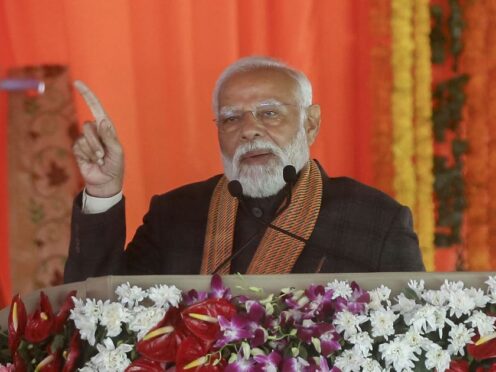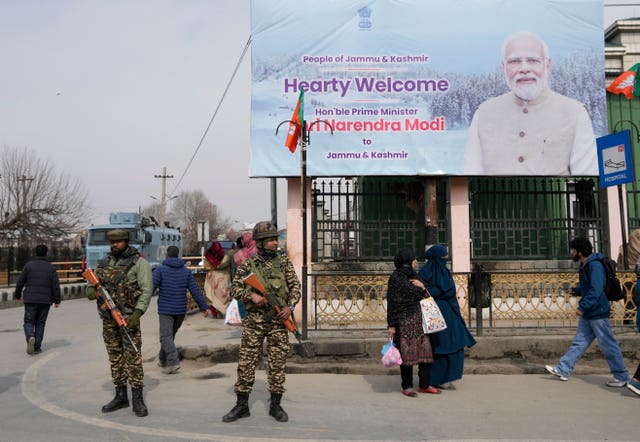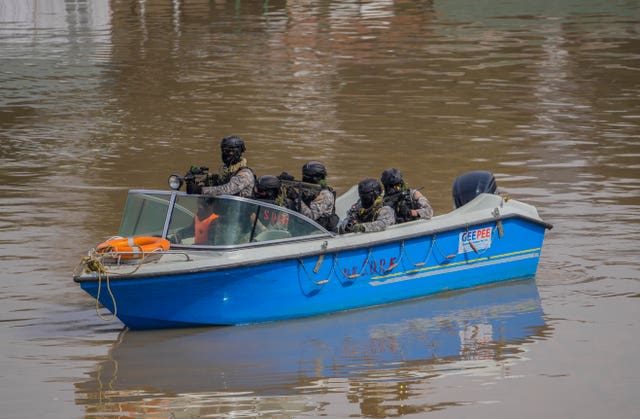
India’s prime minister Narendra Modi has made his first official visit to Kashmir’s main city since New Delhi stripped the disputed region of semi-autonomy and took direct control of it in 2019.
Addressing a crowd in a football stadium in Srinagar, Mr Modi announced development projects, and said previous governments had misled people over the region’s now-scrapped special status.
“The success story of Jammu and Kashmir will be the centre of attraction for the world,” he said, saying that the region had prospered since the 2019 move.

“I have always said that the hard work I am doing is to win your hearts. I will work towards winning your hearts further,” Mr Modi told the crowd.
Mr Modi and his party have accused Kashmir’s pro-India parties of being corrupt, misleading Kashmiris and promoting separatism in the region. Kashmiri politicians, who say their special status was a constitutional guarantee, have called Mr Modi divisive and anti-minority.
Thousands of armed paramilitary troops and police in flak jackets maintained extra vigilance across the Kashmir Valley, the heartland of the rebellion against Indian rule in the majority-Muslim territory where many residents strongly favour independence or a merger with Pakistan. Mr Modi’s two previous visits to Kashmir after its status was changed were to the Hindu-dominated city of Jammu.
Mr Modi did not mention plans to hold elections in the region or to restore its statehood, both demanded by Kashmir’s pro-India political parties. The last election for the regional legislature was held in 2014, but the government elected then was dismissed in 2018.

In 2019, Mr Modi’s Hindu-nationalist government revoked the region’s semi-autonomous status, annulled its separate constitution, split the area into two federal territories — Ladakh and Jammu-Kashmir — and removed inherited protections on land and jobs. The Muslim-majority region is now run by unelected government officials and bureaucrats.
India’s powerful home minister, Amit Shah, has repeatedly promised that the region would regain statehood after elections.
In December, India’s Supreme Court upheld the 2019 decision and asked the government to conduct state polls by September.
The region has been on edge since 2019, as authorities put in place a slew of new laws that many residents fear could change majority-Muslim Kashmir’s demographics. The move was welcomed in much of India, where the Modi government was cheered by supporters for fulfilling a long-held Hindu nationalist pledge.
In New Delhi’s effort to shape what it calls a “new Kashmir”, India has shown no tolerance for dissent, curbing civil liberties and intimidating media.

Ahead of Mr Modi’s visit to Srinagar, government forces laid barbed wires and erected checkpoints on roads leading to the venue. They randomly frisked residents and searched vehicles, while navy commandos in motorboats patrolled the Jhelum River that snakes through the city.
Authorities ordered thousands of government employees, including teachers, to attend the meeting, and most schools in the city were closed for the day.
Thursday’s event is seen as part of Mr Modi’s campaign ahead of national elections scheduled in April and May.
Such security measures have been common in Kashmir since 1989, when rebels began fighting against Indian rule.
Kashmir is divided between India and Pakistan and both rivals claim the Himalayan region in its entirety. India insists the Kashmir militancy is Pakistan-sponsored terrorism. Pakistan denies the charge, and most Kashmiris consider it a legitimate freedom struggle.
Tens of thousands of civilians, rebels and government forces have been killed in the conflict.

Enjoy the convenience of having The Sunday Post delivered as a digital ePaper straight to your smartphone, tablet or computer.
Subscribe for only £5.49 a month and enjoy all the benefits of the printed paper as a digital replica.
Subscribe